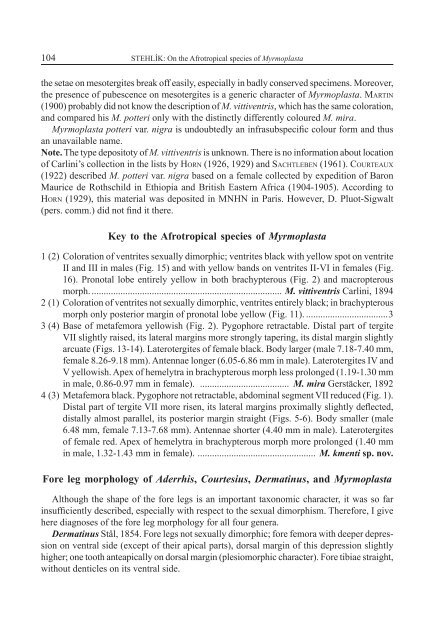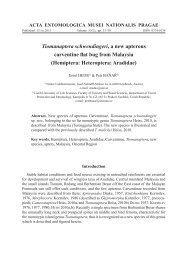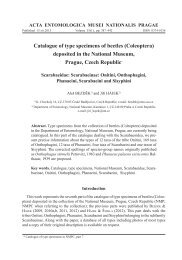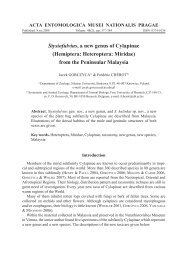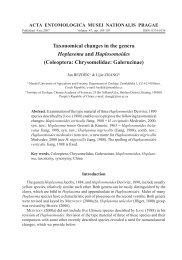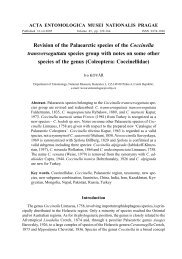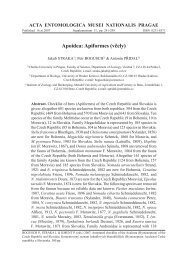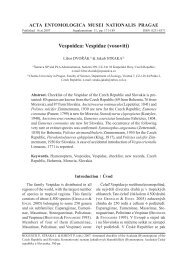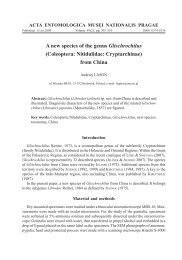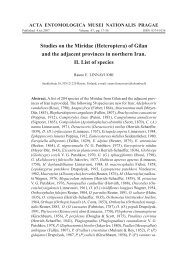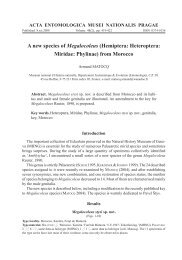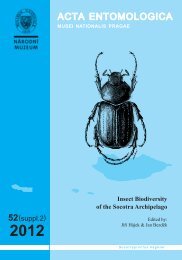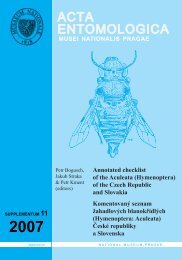On the Afrotropical species of Myrmoplasta - Acta Entomologica ...
On the Afrotropical species of Myrmoplasta - Acta Entomologica ...
On the Afrotropical species of Myrmoplasta - Acta Entomologica ...
Create successful ePaper yourself
Turn your PDF publications into a flip-book with our unique Google optimized e-Paper software.
104<br />
STEHLÍK: <strong>On</strong> <strong>the</strong> <strong>Afrotropical</strong> <strong>species</strong> <strong>of</strong> <strong>Myrmoplasta</strong><br />
<strong>the</strong> setae on mesotergites break <strong>of</strong>f easily, especially in badly conserved specimens. Moreover,<br />
<strong>the</strong> presence <strong>of</strong> pubescence on mesotergites is a generic character <strong>of</strong> <strong>Myrmoplasta</strong>. MARTIN<br />
(1900) probably did not know <strong>the</strong> description <strong>of</strong> M. vittiventris, which has <strong>the</strong> same coloration,<br />
and compared his M. potteri only with <strong>the</strong> distinctly differently coloured M. mira.<br />
<strong>Myrmoplasta</strong> potteri var. nigra is undoubtedly an infrasubspecifi c colour form and thus<br />
an unavailable name.<br />
Note. The type depositoty <strong>of</strong> M. vittiventris is unknown. There is no information about location<br />
<strong>of</strong> Carlini’s collection in <strong>the</strong> lists by HORN (1926, 1929) and SACHTLEBEN (1961). COURTEAUX<br />
(1922) described M. potteri var. nigra based on a female collected by expedition <strong>of</strong> Baron<br />
Maurice de Rothschild in Ethiopia and British Eastern Africa (1904-1905). According to<br />
HORN (1929), this material was deposited in MNHN in Paris. However, D. Pluot-Sigwalt<br />
(pers. comm.) did not fi nd it <strong>the</strong>re.<br />
Key to <strong>the</strong> <strong>Afrotropical</strong> <strong>species</strong> <strong>of</strong> <strong>Myrmoplasta</strong><br />
1 (2) Coloration <strong>of</strong> ventrites sexually dimorphic; ventrites black with yellow spot on ventrite<br />
II and III in males (Fig. 15) and with yellow bands on ventrites II-VI in females (Fig.<br />
16). Pronotal lobe entirely yellow in both brachypterous (Fig. 2) and macropterous<br />
morph. ............................................................................... M. vittiventris Carlini, 1894<br />
2 (1) Coloration <strong>of</strong> ventrites not sexually dimorphic, ventrites entirely black; in brachypterous<br />
morph only posterior margin <strong>of</strong> pronotal lobe yellow (Fig. 11). ..................................3<br />
3 (4) Base <strong>of</strong> metafemora yellowish (Fig. 2). Pygophore retractable. Distal part <strong>of</strong> tergite<br />
VII slightly raised, its lateral margins more strongly tapering, its distal margin slightly<br />
arcuate (Figs. 13-14). Laterotergites <strong>of</strong> female black. Body larger (male 7.18-7.40 mm,<br />
female 8.26-9.18 mm). Antennae longer (6.05-6.86 mm in male). Laterotergites IV and<br />
V yellowish. Apex <strong>of</strong> hemelytra in brachypterous morph less prolonged (1.19-1.30 mm<br />
in male, 0.86-0.97 mm in female). ..................................... M. mira Gerstäcker, 1892<br />
4 (3) Metafemora black. Pygophore not retractable, abdominal segment VII reduced (Fig. 1).<br />
Distal part <strong>of</strong> tergite VII more risen, its lateral margins proximally slightly defl ected,<br />
distally almost parallel, its posterior margin straight (Figs. 5-6). Body smaller (male<br />
6.48 mm, female 7.13-7.68 mm). Antennae shorter (4.40 mm in male). Laterotergites<br />
<strong>of</strong> female red. Apex <strong>of</strong> hemelytra in brachypterous morph more prolonged (1.40 mm<br />
in male, 1.32-1.43 mm in female). ................................................. M. kmenti sp. nov.<br />
Fore leg morphology <strong>of</strong> Aderrhis, Courtesius, Dermatinus, and <strong>Myrmoplasta</strong><br />
Although <strong>the</strong> shape <strong>of</strong> <strong>the</strong> fore legs is an important taxonomic character, it was so far<br />
insuffi ciently described, especially with respect to <strong>the</strong> sexual dimorphism. Therefore, I give<br />
here diagnoses <strong>of</strong> <strong>the</strong> fore leg morphology for all four genera.<br />
Dermatinus Stål, 1854. Fore legs not sexually dimorphic; fore femora with deeper depression<br />
on ventral side (except <strong>of</strong> <strong>the</strong>ir apical parts), dorsal margin <strong>of</strong> this depression slightly<br />
higher; one tooth anteapically on dorsal margin (plesiomorphic character). Fore tibiae straight,<br />
without denticles on its ventral side.


